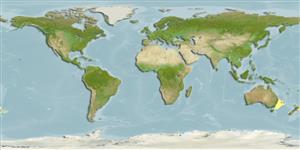Classification / Names
ชื่อสามัญ | ชื่อพ้อง | Catalog of Fishes(สกุล, ชนิด) | ITIS | CoL | WoRMS | Cloffa
>
Aulopiformes (Grinners) >
Paraulopidae (Cucumber fishes)
Etymology: Paraulopus: Paraulopus refers to a taxon related to Aulopus, both being included in the Aulopiformes.; balteatus: Name from Latin meaning 'belted or banded’, referring to the distinctive broad brown bands on
the sides of the body in this species..
Environment: milieu / climate zone / depth range / distribution range
นิเวศวิทยา
เกี่ยวกับทะเล,น้ำเค็ม; ระดับความลึก 300 - 800 m (Ref. 86263). Deep-water
Southwest Pacific: Tasman Sea at 30°35°S, from Browns Mount southeast of Botany Bay, New South Wales, to the Three Kings Ridge just north of the northern boundary of New Zealand’s EEZ.
ขนาด / น้ำหนัก / Age
Maturity: Lm ? range ? - ? cm
Max length : 32.0 cm SL เพศผู้/กระเทย; (Ref. 86263)
Short description
สัณฐานวิทยา | ความยาวต่างๆ
ก้านครีบอ่อนที่หาง (รวม): 11; ก้านครีบอ่อนที่ก้น: 8 - 9; สัตว์มีกระดูกสันหลัง: 48. This species is distinguished by the following characters: A 8-9; pectoral fin rays 19; vertebrae 48; predorsal scales 19-24; scales above lateral line 5.5; pelvic fin large, length 22.8-28.4% SL, larger in males than females, inner lobe much shorter than outer lobe, ratio of lengths of outer lobe to inner 1.7-2.1; two prominent broad brown bands posterior to dorsal fin on sides of body; broad black marginal stripe covering distal third of dorsal fin with distinct broad white submarginal stripe; distal third of upper lobe of caudal fin with white marginal band and black submarginal band, while ventral lobe with black marginal band; buccal cavity pigmented black forward to jaws; males with black anal fin margin anteriorly and distally, females lack dark margins (Ref. 86263).
The absence from trawl collections may infer that this species may prefer hard-bottom habitat, which is usually avoided by trawl fishers. Also, the fact that this species are taken with hook and line suggests that it is carnivorous. Individuals probably rest on their substantial pelvic fins waiting for potential prey to come to them, a behaviour common to a number of other members of the order (Ref. 86263).
Life cycle and mating behavior
วัยเจริญพันธุ์ | การสืบพันธุ์ | การวางไข่ | เซลสืบพันธ์ของเพศเมีย(ไข่) | ความดกของไข่ | ตัวอ่อน
Gomon, M.F., 2010. A new species of Paraulopus (Aulopiformes: Paraulopidae) from seamounts of the Tasman Sea. Memoirs of Museum Victoria 67:15-18. (Ref. 86263)
IUCN Red List Status (Ref. 130435)
Threat to humans
Harmless
Human uses
ข้อมูลเพิ่มเติม
ชื่อสามัญชื่อพ้องกลไกการเผาผลาญพลังงานผู้ล่าการศึกษาเกี่ยวกับผลกระทบของสารประกอบทางเคมีที่เป็นอันตรายต่อสิ่งมีชีวิต ประชากร และสิ่งแวดล้อมการสืบพันธุ์วัยเจริญพันธุ์การวางไข่การรวมกลุ่มวางไข่ความดกของไข่เซลสืบพันธ์ของเพศเมีย(ไข่)Egg development
Age/SizeการเจริญเติบโตLength-weightLength-lengthLength-frequenciesความยาวต่างๆสัณฐานวิทยาตัวอ่อนพลวัตของสัตว์น้ำวัยอ่อนการทดแทนที่อุดมสมบรูณ์BRUVS
อ้างอิงการเพาะเลี้ยงสัตว์น้ำประวัติการเพาะเลี้ยงสัตว์น้ำสายพันธุ์พันธุศาสตร์ElectrophoresesอัตราพันธุกรรมโรคการแปรรูปNutrientsMass conversion
ผู้ร่วมมือรูปภาพหลายรูปStamps, Coins Misc.เสียงปลามีพิษ เช่น ปลาปักเป้าความเร็วรูปแบบการว่ายน้ำพื้นที่เหงือกOtolithsสมองวิสัยทัศน์
เครื่องมือ
Special reports
Download XML
แหล่งที่มาจากอินเตอร์เน็ต
Estimates based on models
Preferred temperature (Ref.
123201): 6.4 - 11.7, mean 8.8 °C (based on 19 cells).
Phylogenetic diversity index (Ref.
82804): PD
50 = 0.5001 [Uniqueness, from 0.5 = low to 2.0 = high].
Bayesian length-weight: a=0.00389 (0.00180 - 0.00842), b=3.12 (2.94 - 3.30), in cm total length, based on all LWR estimates for this body shape (Ref.
93245).
ระดับชั้นอาหาร (Ref.
69278): 4.2 ±0.7 se; based on size and trophs of closest relatives
Fishing Vulnerability (Ref.
59153): Low to moderate vulnerability (29 of 100).
